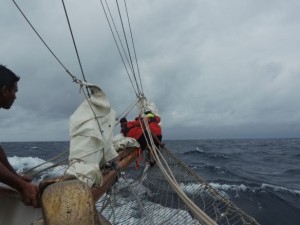By the time Lieutenant Thomas Roebuck compiled his lexicon of the Laskari language (An English And Hindostanee Naval Dictionary, first published in Calcutta in 1811) the dialect was already centuries old. The clearest proof of this lies in the contents of the Naval Dictionary, a large number of which are derived from Portuguese. Indeed Laskari was probably the conduit for the introduction of many of the most widely used Portuguese-derived words in India.

Consider the word ‘balti’ for instance; derived from the Portuguese ‘balde’, it probably referred originally to ship’s buckets:
today, no Indian household is

complete without a set of tin or plastic baltis,
just as no English town is without its supply of ‘balti chicken‘, which was probably also a Laskari invention.
Similarly the word ‘kamra’, which is now used to signify ‘room’ in many Indian languages, came from the Portuguese ‘camara’, itself a derivative of the Latin ‘camera’ (room, vault). The word was almost certainly introduced through Laskari, in which it was used to mean ‘ship’s cabin’.
That Portuguese had a formative influence on Laskari is evident also from the frequency with which the dialect resorts to it in naming the basic anatomy of the ship.

The Laskari for cutwater, for example, is ‘tâliyâmâr’, from Portuguese ‘talhamar’; and the word ‘trikat’, meaning ‘fore’, as in ‘fore-mast’, comes from the Portuguese ‘traquete’.
Many Laskari words for ship’s parts are also taken from Hindusthani and other Indian languages: thus a deck is a ‘tootuk’, a mast is a ‘dol’ and a sail is a ‘serh’ or ‘pal’. Some of these terms have a rustic directness: the truck, or seal of the mast, becomes, for example, a ‘laddu’ [rounded sweetmeat]. These terms in turn enter into ever-more specific and complicated combinations with other linguistic influences in order to describe the many parts of the vessel. Thus, the Laskari term for fore-top-sail is constructed by joining ‘trikat’, ‘gâvî’ and ‘serh’, to form ‘trikat-gâvî-serh’ (or simply ‘trikat-gâvî’); similarly the fore-topgallant-sail is the ‘trikat sabar’; the fore-royal, the ‘trikat tabar’; the fore-topmast-staysail, the ‘trikat-gavi-sawai’, and the fore-topgallant-studdingsail, is the ‘trikat-sabar-dastur’. And so on.

English was another resource that Laskari drew upon in describing a ship: thus a hawser becomes a ‘hansil’ in Laskari; a jack-block becomes a ‘jugboolak’; a martingale becomes a ‘mâtanghai’, and the cable known as the messenger becomes a ‘masindar’. In this process of naming, languages often met and married, with curious and picturesque results. On many sailships, at the interesections of some of the masts and yards, there were small ledges that provided sailors with a temporary refuge from the harrassment and surveillance of their superiors: there they were were wont to spend their leisure-time, smoking, gossiping and telling tales. In English these intersections were called ‘cross-trees’: Laskari took some of these syllables and turned them into ‘kursi’, which is a homonym for the commonly-used Arabic-derived Hindusthani word for ‘chair’: no doubt that was exactly the purpose served by this happy intersection of spar and mast.

The words for the complex set of lateral masts that project forward from a ship’s bows – the jib, jib-boom etc. – also produced interesting intersections of language.
The spar that sprouted from the head of the ship became a ‘jîb’, which means ‘tongue’ in some Indian languages; from a crossing of Arabic, English and Hindusthani came the word for flying-jib, ‘fulâna-jîb’, which might be translated as the ‘anyone-tongue’, and the outermost part of the jib-boom, where many a lascar lost his life, was the ‘shaitân-jîb’ – the Devil’s-tongue.
